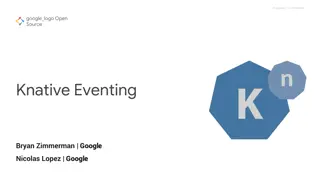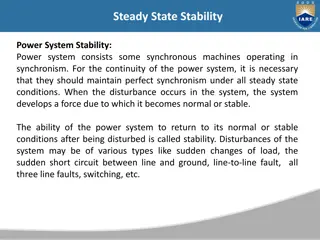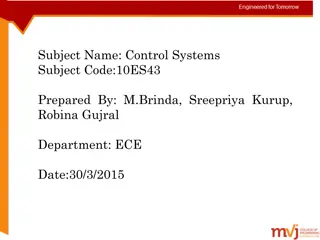Stability Patterns to Combat Microservices Antipatterns
Explore stability patterns introduced by Henrik Børbak Christensen to combat 14 common microservices antipatterns, such as blocked threads, slow responses, and chain reactions. Learn about the importance of timeouts, fault isolation, and guarding critical regions to enhance system reliability and performance.
Download Presentation

Please find below an Image/Link to download the presentation.
The content on the website is provided AS IS for your information and personal use only. It may not be sold, licensed, or shared on other websites without obtaining consent from the author. Download presentation by click this link. If you encounter any issues during the download, it is possible that the publisher has removed the file from their server.
E N D
Presentation Transcript
Microservices and DevOps Scalable Microservices Stability Patterns Henrik B rbak Christensen
Anti --- Antipatterns Nygaard lists 14 antipatterns Users, blocked threads, slow response, chain reactions, etc. So how to combat these??? The Stability Patterns (and the Remember this section in each antipattern chapter, which mentions stability patterns that are not mentioned in this chapter, hmmm) CS@AU Henrik B rbak Christensen 2
Summary Note: Figure from first edition! Missing in 2nd Ed, and a bit different pattern set But nevertheless CS@AU Henrik B rbak Christensen 3
Is All This Clutter Necessary? As stated by Nygard: handling all the possible timeouts creates undue complexity in your code. It certainly adds complexity. Your users may not thank you for it, because nobody notices when a system doesn t go down, but you will sleep better at night. CS@AU Henrik B rbak Christensen 4
Timeouts Timeouts: Guard any call to remote units with timeout to avoid waiting forever on an answer that never arrives Well placed time-outs provide fault isolation: your code does not break due to a failure in another subsystem. Beware of vender supplied APIs, sometimes they have forgotten to add time out parameters Or it is in the API, but not implemented CS@AU Henrik B rbak Christensen 5
Timeouts Timeouts: Guard any call to remote units with timeout to avoid waiting forever on an answer that never arrives Apply to Integration Points, Blocked Threads, and Slow Reponses Consider delayed retries Network issues take time to go away do not retry again immediately See Retry pattern (that I introduce) later CS@AU Henrik B rbak Christensen 6
Timeouts on Locks Java supports running multiple threads To avoid weird stuff you need to guard critical regions i.e. the method that two or more threads may call at the same time Classic Java Synchronized methods Modern Java ReentrantLock myLock; Acquire not by myLock.lock() but By myLock.tryLock(3, TimeUnit.SECONDS) cannot time out! CS@AU Henrik B rbak Christensen 7
Circuit Breaker The idea of a fuse: Burn before your house does! Circuit breaker: Da: Maksimalafbryder en automatisk afbryder, som bruges til udkobling af overstr mme. Best r af bryderdel og rel del. Rel delens funktion er at m le str mmen og i tilf lde af en overstr m udkoble af- bryderen HFI rel CS@AU Henrik B rbak Christensen 8
Circuit Breaker Circuit Breaker: Wrap dangerous operations with a component that can circumvent calls when the system is not healthy. Differs from retries, in that circuit breakers exist to prevent operations rather than to re-execute them. CS@AU Henrik B rbak Christensen 9
Circuit Breaker Closed state: Execute operation as normal If operation fails (timeout) then Note it (increment failure count) If failure count > threshold then Open Open state: Fail fast, avoid the wait for timeout After a set time, switch to Half-open Half-open state: Execute operation again if fail then goto Open state immediately if success then goto Closed state Exercise: Why the need of the half-open state? CS@AU Henrik B rbak Christensen 10
Circuit Breaker Is a way to make graceful degradation Degrade functionality when under strain Avoid DogPile, as it gives producer service time to recover Important to involve stakeholders What to do if in the open state? What to do if we cannot verify credit card? Remember Use together with timeouts Expose, track and report state changes Log any popped fuses ! CS@AU Henrik B rbak Christensen 11
NetFlix NetFlix is a large micro service system, based upon circuit breakers. Open sourced their circuit breaker implementation w. dashboard CS@AU Henrik B rbak Christensen 12
Resilience4J is A lightweight, easy-to-use fault tolerance library inspired by Hystrix, but designed for Java 8 and functional programming. You can pick and choose just the piece you want CircuitBreaker: Nygard s pattern in it s frequency form Bulkhead: Limit number of concurrent executions RateLimiter: Limit rate of requests (or queue them) Retry: Retry call N times with M mS delay between TimeLimiter: Nygard s Fail Fast pattern Cache: You guessed it CS@AU Henrik B rbak Christensen 13
Bulkheads Da: Skot Partitions that can be closed preventing water from moving from one section to the next Damage containment Bulkheads: Partitioning a system so failures in one part does not lead to system failure Simplest (most common) form: Redundancy Have two or more servers handling the load CS@AU Henrik B rbak Christensen 14
Bulkheads Mission-critical form: Pool of servers/services reserved for critical use while the rest are available for non-critical use Example Servers dedicated to airline check-in (critical) Others serve flight status checking (non-critical) Liability (see next slide) You now have two disjoint resource pools that are subject to unbalanced capacities I.e. you need more reserved capacity CS@AU Henrik B rbak Christensen 15
Bulkheads CS@AU Henrik B rbak Christensen 16
Steady State Steady state: For every mechanism that accumulate resources, some other mechanism must recycle that resource. If not, accumulated resources outgrow capacity Log files, DB rows, caching, If capacity is exceeded - bad things happen CS@AU Henrik B rbak Christensen 17
Examples MongoDB Allocated disk in max 2GB chunks If it cannot, it simply stops processing write requests, only processing read requests Will not reenable write requests until after restart (and data purge and compacting is a write request ) Docker container logs are written to storage So if you never look at them, they just grow CS@AU Henrik B rbak Christensen 18
Steady State Another potential definition Steady state: A system should be able to run indefinitely without intervention Otherwise, you get used to fiddling Which leads to what Nygard terms oh-no-second The split second when you realize you have hit the wrong key, shut down the wrong server, deleted the wrong DB table My personal fear was db.GFKRE003.drop() 6TB of data from 4 years of data collection CS@AU Henrik B rbak Christensen 19
My own Fiddling trick A linux shell looks like a linux shell Make staging machines and production machines look different! Production machine always have awful color choices! I do not mistake one for the other! I hope CS@AU Henrik B rbak Christensen 20
Steady State Data purging Remove old data from the DB Can be pretty tricky in RDB Referential integrity, orphaned rows, And perhaps even more so in NoSQL Log files If not purged, you run out of disk space Java.io.IOException! Dump a stacktrace in the face of the user Review the Log4J RollingFileAppender for non Docker use For Docker, you write to StdOut which is stored Rewire to a logging system like ELK or Humio instead Which then run out of disk space CS@AU Henrik B rbak Christensen 21
Fail Fast Fail fast: Check resource availability at the start of a transaction, and fail immediately in case any is not available. If not, you waste CPU and human time doing stuff that will eventually have to be redone or undone Cook s: mise en place Find all ingredients before starting Or the fish will burn while to try to find the chili paste CS@AU Henrik B rbak Christensen 22
Fail Fast Part of fail fast is also to validate human entered values as best possible before proceeding Typically values entered in web form or similar Avoid connecting the DB and do a query only to find that one of the query parameters were null Fail Fast is a way to combat slow response Example: CPF system will fail immediately if a key is not found in file. CS@AU Henrik B rbak Christensen 23
Let it Crash Let it Crash: Create system-level stability, by sacrificing service-level(*) stability. The cleanest state your program has, is right after startup. Nygard writes component-level , but guess that is synonym with our services . Require Limited granularity: isolate the crash to the service Avoid cascading failures Fast replacement: Only let it crash if restarts are quick Supervision: Don t do local restarts, monitor on higher level Reintegration: Consider how back to work is orchestrated Inspired by the Erlang programming language CS@AU Henrik B rbak Christensen 24
Let it Crash We will return to HEALTHCHECK in Dockerfiles and compose-files. Allows Granularity is the container Restart by the swarm (restart time is within the ~seconds) Simple supervision and reintegration is built-in in the swarm s stack Restart-policy CS@AU Henrik B rbak Christensen 25
Handshaking Handshaking: Allows a client to assess whether a server has the capacity to answer a request, essentially providing the server the ability to tell the client to back off Compare Ping-echo and Heartbeat tactics Actually not implemented in most modern protocols, like HTTP, RMI, etc. You will probably have to implement it yourself Watch out for doubling the traffic: can I do (1), then I do (2) Any HTTP call is expensive CS@AU Henrik B rbak Christensen 26
Test Harness Test Harness: A substitute for the remote end of an integration point that produce out-of-spec failures Like Refuse connection, accept and then die, packet loss Slow responses, garbage responses, protocol errors Send one byte every 30 seconds (DOS attack), send Megabyte long replies instead of Kilobyte long replies Send HTML instead of XML, refuse all authentication credentials, CS@AU Henrik B rbak Christensen 27
Test Harness Da: Selet j Integrations test: Testing that the parts are working together to identify integration failures Obviously closely related to integration points and the large set of stability antipatterns Nygard: No it is not strong enough Integration tests test within-spec failure modes Operations excel in out-of-spec failure modes !!! You do not get an error code from the remote server, it simply does not reply, or provide slow response CS@AU Henrik B rbak Christensen 28
Decoupling Middleware Middleware decisions effect the implementation cost of systems significantly Learn many architectural styles to ensure you pick the right one CS@AU Henrik B rbak Christensen 29
Shed Load The world can always create more load than you can handle There is no difference between really, really slow and down . Shed load: Refuse new requests, if load gets too high. Similar to fail fast but you do not fail on service-level but on request-level Not time out exception but 503 service unavailable Guard calls to shed-loading services with circuit breakers or timeouts or Meaning of Too high ? Monitor own SLA to determine the tripping point Newman: SLOs and SLIs Shed = skille sig af med CS@AU Henrik B rbak Christensen 30
Shed Load Back in the Queue Theory stuff Systems with randomly timed requests will follow this distribution as the workload increase response times increase exponentially Shed load when you hit the upper parts of the knee CS@AU Henrik B rbak Christensen 31
Create Back Pressure Every performance problem starts with a queue backing up somewhere Little s law: L = lambda x R L = number of requests in queue R = response time of request R = W + S, wait time + service time lambda = arrival rate So lambda is constant (influx of requests from the world) If response time gets longer (S large (dankortterminal i stykker) ) then more requests in queue and then queue eats all memory => crash (Think F tex kasse queue) (Think time until I leave ) (in line + getting served) (arrival per sec, of custom.) CS@AU Henrik B rbak Christensen 32
Create Back Pressure So we do not want unbounded queues! Bounded queue, what to do with out of space ? Pretend to accept new item, but actually drop it Accept new item, drop something else in queue Refuse the item ( = shed load) Block request (producer) until there is room in queue Dropping options In many real-time systems, only latest reading is interesting Aircraft flight control who gives a damn about that angle the rudder was in 30 seconds ago more interesting what is now CS@AU Henrik B rbak Christensen 33
Create Back Pressure Block producer option Introduces flow control , applying back pressure upstream (probably) propagates all the way back to the client, who will be throttled down until queue releases Create Back Pressure: Use finite queues and block producers if queue overflows, to slow down instead of crashing [Own definition] Alternative to shed load May lead to blocked threads obviously Are we crashed or just extremely slow? Only use within system boundaries Use shed load across system boundaries instead, like open internet CS@AU Henrik B rbak Christensen 34
Ex My Lyon airport load test MongoDB was slow, so node memory exhausted Solution I set the prefetch to 1! Now Java connector does not fetch next until MongoDB has stored it (acknowledge message) Thus, the RabbitMQ itself acts as Queue, rather than the consuming node s heap acting as queue! Thus applying back pressure upstream until I hit a service that can actually handle the pressure CS@AU Henrik B rbak Christensen 35
Governor Steam engines: They can run so fast, they will break! Engineering device: Put a speed limit on: the governor Govenor: Stateful and time-aware control plane logic that prevents a system from exceeding its safe limits. Actions within safe limit should be fast, outside increasing resistance must be applied Shutting down instances is unsafe, deleting data is unsafe Antidote for the force multiplier antipattern Safe limits is kind of U-shaped curve Slow actions down if moving outside the buttom of the U curve CS@AU Henrik B rbak Christensen 36
Bounded Result Sets Nygard does not mention a pattern to combat unbounded result sets Should be reasonably obvious Bounded Result Sets: Return large results sets in chunks that can be iterated. (Pagination) Not get bible , but get bible, page 7564, page 7565, Mongo: use find().skip(n*page).limit(n) CS@AU Henrik B rbak Christensen 37
Retry Perhaps too obvious, but Why does Nygard not mention Retry as a pattern? Only indirectly in time outs pattern Retry: If a request fail/time out, then retry the request some time later a number of times before giving up Only do it, if it makes sense! And who does the retry? Fixed retry intervals Beware: May lead to dogpiles! We herd the calls together in lumps Gaussian retry intervals (?) Exponential backoff Retry after 1s, 2s, 4s, 8s, 16s, and then give up. CS@AU Henrik B rbak Christensen 38
Use Timeouts Example Exponential Back-off Wait 1 second, then 2, then 4, then 8, then 16 CS@AU Henrik B rbak Christensen 39
Who does Retry? Exercise: PlayerServant delegate to CaveStorage delegate to MongoDB MongoDB s primary fails and throws exception We will talk about passive replication technique shortly Exception caught in CaveStorage but Handle it locally in CaveStorage and do a retry? Rethrow as ElectionException and handle in PlayerServant? Pro and Con of each solution? CS@AU Henrik B rbak Christensen 40
Experience F2020 In design for failure in F2020 I herded students into trying to find graceful degradations Like retries General impression Seemed that the code became cumbersome and the results for the users not quite intuitive dig n My new room Could not dig your room, will retry later So this year Fail fast and report it Could not dig your room, you have to try again later ??? CS@AU Henrik B rbak Christensen 41
Summary Phew Plus Shed load Back pressure Govenor Bounded Result sets Retry CS@AU Henrik B rbak Christensen 42

























